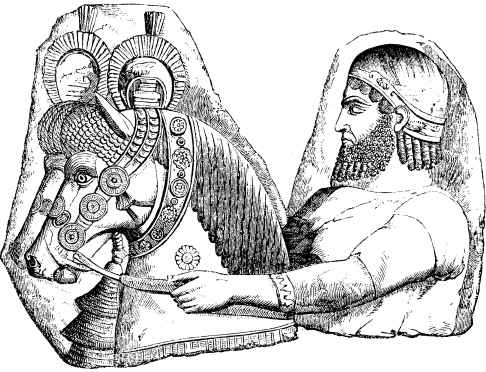SOMETHING ABOUT THE HORSE.
763

the heads of the horses rise
gracefully plumed and fanciful crests, ornamented with long ribbons
or streamers, which were probably of many colors. The bridle consisted of
a head-stall, a strap divided into three parts joining the bit,
together with straps over the forehead, under the cheeks, and
behind the ears. Embroidered trappings, such as are described by
Ezekiel as the precious clothes for chariots from Dedan,
covered the backs of the horses. The bits, as well as the metal used
in the harness,

ASSYRIAN WAR-HORSES.
were often of gold and other
precious metals. The manes were either allowed to fall loosely on the
neck, or were more frequently plaited; the tails were bound in the centre
with ribbons adorned with tassels. The most gorgeous displays of
cavalry in modern times must be incomparably behind those early days
in every thing that constitutes grandeur either in numbers or costly
in uniforms.
Horses are subject to
uncontrollable fits of terror, and many incidents are remembered
iltustrative of this nervous sensibility. To horses thus seized, if
in large numbers, and accuslomed to military discipline, the effects
are very terrible. In June, 1810, Colonel R. M. Johnson's regiment
was stationed on a beautiful grass plain, near St. Josephs. At midnight
some of the horses grazing in the vicinity became alarmed, which
instantly communicated itself to those belonging to the regiment, and the
whole body united in solid columns, and commenced a whirlwind course
around the camp. Incredible as it may seem, so compactly did they
keep together in their fear, that the whole body of six hundred did not
seem to occupy a space of more than forty by sixty yards. The moon was
shining in full splendor, the camp was an open plain, and the scene
presented was awfully sublime. At length the horses forced a passage
through the lines, overset tents, carried away the fences, and were soon
lost in the surrounding woods. Many were found the next day twenty and
twenty-five miles distant, and all were more or less lamed, or otherwise
injured by having their hind-legs cut by the feet of those crowding in the
rear. A more thrilling illustration is recorded among the incidents
of the Peninsular war. Two of the Spanish regiments which had been
stationed at Funen were cavalry, mounted on choice Andalusian horses, the
whole numbering over eleven hundred. In retiring from the place it
was found
impossible to bring the animals
away, and the commander and men were too much attached to their steeds to
deliberately destroy them, so their bridles and housings were taken off,
and they were turned loose upon the beach. A scene ensued, such as
probably was never before witnessed in equine exhibitions, surpassing in
all the elements of terror the bloody scenes of the Roman circus. The
abandoned horses, apparently sensible that they were no longer under
human protection, and seemingly despairing of life, ranged themselves
in squadrons, retaining, meanwhile, the strictest military discipline.
Once in position, they charged on each other, biting, tearing, and
kicking with the most ferocious rage, and trampling upon those which were
beaten down, until the shore became strewn with the dead and disabled.
Part of the animals had been turned loose on rising ground in the
distance, but no sooner did these warriors “smell the battle afar off,”
than they came thundering like a whirlwind over the intermediate hedges,
and catching the prevailing madness, plunged with equal fury into the
raging fight. Sublime as was the scene, Romano and his men found it too
horrible to contemplate, and too dangerous to interfere; and when the last
boat quitted the beach, the few surviving horses were to be seen still
engaged in the work of mutual destruction.
In the steppes of Russia it is
not uncommon to see a young colt, made furious by the persecution of
his enemies, rush singly at a band of wolves, and striking out with his
fore-feet, pound his enemy beneath his murderous pestles, and then seize
them by the shoulders and toss them into the air. These horses are made
savage by the extreme changes of climate which they arc subjected to; at
one time broiling under a tropical sun, at another bewildered amidst
snowstorms, and by hurricane winds scattered over the frozen surface
of the Black Sea,